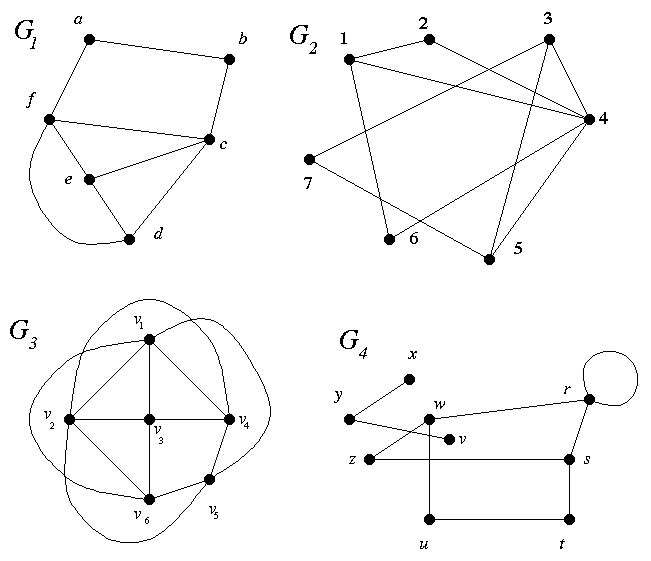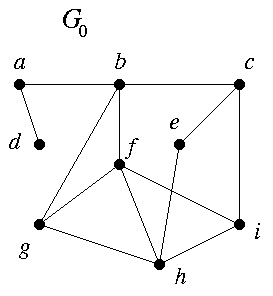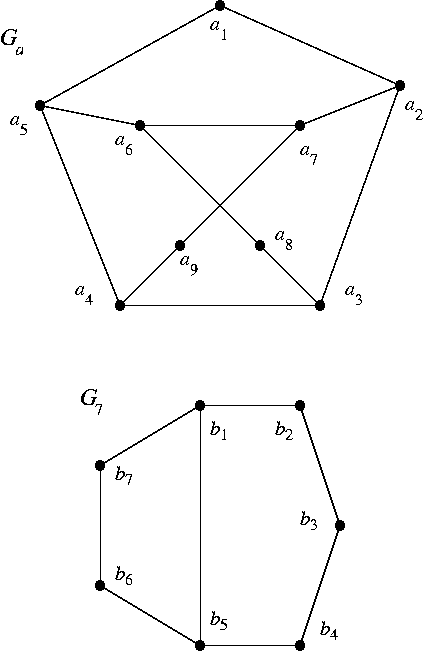Good Advice and General Instructions
on homework problems
Write out solutions to all the questions you do, not only the ones for handing in.
Do as many questions as you can that are not hand-in problems. The class discussion is about them, and discussion is how you learn half your graph theory. If you haven't tried the problems, you don't get so much out of the class discussion, nor out of talking with your friends.
Besides finding the answer, always try to explain, as well as you can, how you know you have the correct answer. This is an important part of your solution. An answer without explanation is not worth much (except for very simple questions).
When solving problems, a systematic solution is better than guesswork. You often may find a solution by intelligent guessing, but then you should look for a way of showing that your solution is correct. This part needs to be systematic if it is to be completely convincing. (This will be clearer after a few days of class!)
Allow 15 minutes per problem (minimum) before you give up, even if you feel you're getting nowhere. These problems need time for thought. If you're still stuck, go on to another problem. Return to the sticky problem later (say, the next day). Often, it then looks easier because you tried hard the first time and then gave your mind time to grind it up--I mean, to come up with ideas. To get the advantage of this method, you have to start the problems well ahead of time. Last-minute effort will not work well in this class.
Rules for hand-in homework.
(1) Hand in a final draft: neat work that is well organized and not cramped. Use as much space as you need. Please also leave some extra space between problems for our comments.
(2) You may discuss hand-in HW with other people, but you must write it up in your own words.
(3) No little stubbies from tearing a page out of your notebook. Remove them neatly.
(4) Fasten the pages securely. That means stapling or a paper clip, not folding the paper over and/or tearing it (not secure!).
I reserve the right to reduce grades for not following these rules.
Go to announcements | course information | syllabus | homework index.
Graph Theory Homework: Complete
This assignment is for discussion in class (except as called "Hand In"). Come up with ANY IDEAS AT ALL and bring them along!
Due Tues., 1/25:
Due Wed. 1/26:
Hand in Wed. 1/26:
Some terminology about a graph (from the announcements page): A1. (a) Find a separating set. (b) Find one that is smallest.
A2. (a) Find a disconnecting set. (b) Find one that is smallest.
A3. Write down the degree sequence of G = G1, G2, G3. (Omit G4.)
A4. Treat G as a graph in which the vertices stand for people and the edges join pairs who don't get along together, so they can't be on the same committee. What is the largest possible committee?
Homework Set I (1/24)
Do ## A1, A2, A4 for G = G1 (do this first) and G2, G4.
Also, read to the middle of page 9 (changed) in the textbook.
Also, read the course information page and the homework instructions.
# A3 (again, do G1 first).
## A1–A4 for G3.
Problem Set A
vertices edges whose removal leaves a disconnected graph.

Go to homework index.
ADDED: Due Tues., 1/25:
Hand in Fri., 1/28:
Due Fri., 1/28:
B1. This problem concerns ways of testing graphs for being isomorphic or nonisomorphic. In each part, suppose G and H are isomorphic graphs.
The point is that, if G and H are graphs that fail any one of these properties, then they cannot be isomorphic (by contradiction). But the converse is not true, as the next problem shows.
B2. For each property in # 1, find a pair of graphs, G and H, that are not isomorphic but which Homework Set II (1/24, 26)
Read all of Sections 1.1 and 1.2.
## B1(a,b), B2(a,b).
Do for discussion: ## B1(c), B2(c) (think about them for a few minutes; we'll discuss them in class).
Correction: Parts (c) are the degree-sequence questions.
Problem Set B
fail have the property. Specifically:
Go to homework index.
For Mon. 1/31: Read Section 1.3.
Do for discussion Tues. 2/1:
Do for discussion Hand in Fri. 2/4:
C1. This concerns Theorem 1.1.2 and the example G0. I follow the book's notation.
The sequence
C2. In the graph F of Figure 1.1.16:
C3. Let G be a graph which has a cycle. Let C be a cycle in G. Let a, b be arbitrary vertices in G, and let e be any edge in C. Explain in detail why, if G has a path connecting a to b, so does G - e.
Homework Set III (1/29)
Remember to check the announcements page for corrections.
Sect. 1.1, ## 1, 2, 4(a-c), 6.
Sect. 1.2, # 1, 4, 7.
Wed. 2/2 Fri. 2/4 (Changed due to Wed. cancellation):
Sect. 1.1, # 9.
Sect. 1.2, ## 2, 3, 6, 8.
# C2.
Sect. 1.1, ## 3, 4(d), 5, 7, 8.
Sect. 1.2, # 5.
## C1, C3.
Problem Set C

(S1) (4, 4, 4, 3, 3, 3, 2, 2, 1)
is known to be graphic, because it is the degree sequence of G0. From (S1) the rule of Theorem 1.1.2 gives
(S2) (3,3,2,2,3,2,2,1),
which, when rearranged in descending order, is
(S3) (3,3,3,2,2,2,2,1).
A solution is available here.
Go to homework index.
For Mon. 2/7: Read Section 2.1.
Do for discussion Wed. 2/9:
Do for discussion Fri. 2/11:
Hand in Mon. 2/14:
Homework Set IV (2/4)
Sect. 2.1, ## 1-4, 8, 13, 18, and 9-10 (for P5, K4,4, D, and O).
## D1, D3.
Sect. 2.1, ## 6, 11, 14, 16, 17.
# D4.
Sect. 2.1, ## 5, 7, 15(a), 19, 20, and 9-10 (for I).
## D2, D5.
Textbook Corrections
- The definition of a cycle on p. 16 is valid for n ≥ 3 but not for n = 1 or 2.
- In the proof of Theorem 1.3.5, at the top of p. 20, insert the sentence: "Then follow P2 back to v1." before "Then we have a cycle."
- In Exercise 2.1 # 4, you should find
(a) any critical subgraph;
(b) a critical subgraph whose chromatic number equals that of the whole graph. - The graph I in Figure 1.2.5 is the one without a label. (It's the icosahedral graph.)
Problem Set D
D1. Suppose the average degree of a graph G is > 2. [Note: This should have said G is connected. – 2/18]
(a) Prove that G contains at least 2 cycles.
(b) Prove that it is possible for G to have exactly 2 cycles.
A solution is available here. (Hint for D2: Use a similar idea, but you have to add something.)
D2. Suppose G is a connected graph whose average degree is 3.
(a) Show that G has at least 4 cycles.
(b) Is 4 the best possible number? Or can you prove that G must have 5 or more cycles? 6 or more?
D3. Find the chromatic number χ(G) where G is the graph in Figure 2.1.5.
D4. Is the graph of Figure 2.1.5 critical? Prove. (Don't believe everything you read!)
D5. Is the graph of Figure 2.1.6 critical? Prove.
Go to homework index.
